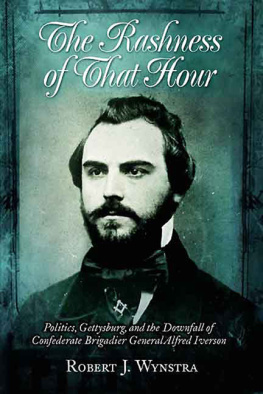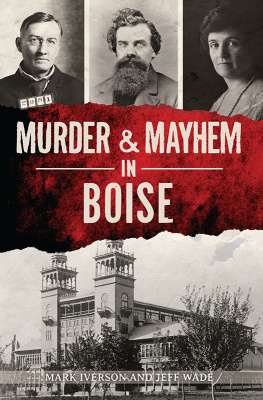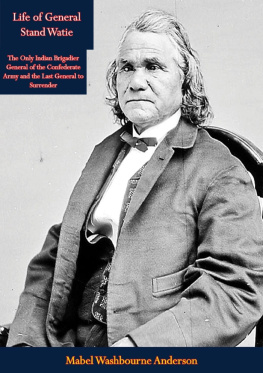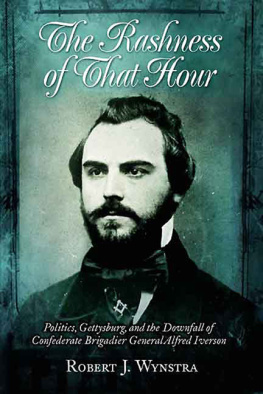Acknowledgments
This book would not have been possible without the help of those individuals listed herein. The assistance of Gary Kross, Gettysburg licensed battlefield guide, proved especially crucial. He generously provided me with unlimited access to his trove of Iverson family papers and photographs. He also accompanied me on several walks of the Gettysburg battle sites associated with Iversons Brigade and helped shape my understanding of the events that took place there. Without his help and encouragement, my task would have been much more difficult.
The contributions by Henry Mintz of Shelby, North Carolina, were just as essential. His determined sleuthing through the archives located in North Carolina and the South provided much of the source material used in this book. Time after time, he uncovered previously unknown documents that led to new avenues of inquiry regarding the political feuds that dominated Iversons Brigade. He proved equally adept at locating important period photographs. In many ways, this book is as much his as it is mine.
Steve French from Hedgesville, West Virginia, generously perused several manuscript versions and provided me invaluable documents and pieces of information. His help throughout the long hours of research and writing is greatly appreciated. Gregory White provided similar encouragement and went the extra distance to provide me with several newspaper accounts and other important documents from his home state of Georgia. Charles Teague from Gettysburg kindly reviewed my manuscript and helped me obtain several elusive documents. But even greater was his enthusiasm for my efforts; he helped me move ahead whenever my spirits flagged.
Thanks are also due to Eric J. Wittenberg for his early interest in my project and his kind assistance over the years. J. David Petruzzi also deserves special thanks for his encouragement and interest in my manuscript. Without their help, this book would have suffered many more delays in getting published. In addition, Scott Mingus willingly shared information on Confederate activities in the area outside of Gettysburg. I would also like to acknowledge Robert deButts for granting me permission to quote material from the Lee Family Papers at the Virginia Historical Society. Raymond J. DeStefano generously allowed me to quote from an important Gettysburg letter in his collection.
Greg Mast was extremely helpful in securing several photographs for use in this book. His kind assistance is greatly appreciated. Garry Adelman provided invaluable help in obtaining photographs of the Gettysburg battlefield. Thanks also to R. Carol McLean from Rockingham, North Carolina, for granting me permission to use the photograph of his relative, Pvt. Solomon McLean of the 23rd North Carolina, and to Lindsey Lambert from the Brock Historical Museum at Greensboro College for providing an image of Charles Force Deems. Gary Beaumont and L. Brian Stauffer provided invaluable assistance in scanning and preparing my photographs.
Without exception, the staff from the public and private archives and other institutions that provided source material for this book were remarkably helpful. Special appreciation for their assistance is due to John Coski from the Museum of the Confederacy and Sion Harrington III from the North Carolina Office of Archives and History. Bev Tetterton from the North Carolina Room at the New Hanover County Library in Wilmington, North Carolina, displayed unparalleled efficiency in providing me with material from the Cowan and Denson Family Papers.
Maps play an essential role in any book of military history. In this case, George Skoch masterfully handled the task of preparing those that appear in this book. His professionalism and skill shine through on each of them.
I am especially honored that historian Robert K. Krick, whose knowledge of the Army of Northern Virginia is unsurpassed, took the time to review the manuscript and offer important suggestions I endeavored to incorporate.
Without Theodore P. Savas, the managing director of Savas Beatie, this book would not have been possible. His enthusiasm and unmatched professionalism made every step in the process remarkably enjoyable. In all respects, he is truly a dream publisher. I would also like to thank Kimberly Largent-Christopher, who helped with an early draft of my manuscript.
Lastly, I would like to thank Anita Povich for enduring several years of talk about someone named Alfred Iverson. Every time I faltered, she was there to pick me up and prod me forward. Many times, she possessed more faith in my ability to pull off this project than I did. Without her support and encouragement, I certainly would still be struggling to write this book.
Robert J. Wynstra
I NTRODUCTION

The Horrors of That Day
A rguably, no commander in the Army of Northern Virginia suffered more damage to his reputation at Gettysburg than did Brig. Gen. Alfred Holt Iverson of Georgia. In little more than an hour during the early afternoon of July 1, 1863, much of his North Carolina brigade was slaughtered just north of the town in front of a stone wall on Oak Ridge. Amid widespread rumors that he was a drunk and a coward who had slandered his own troops, Iverson was stripped of his command in Maj. Gen. Robert E. Rodes Division less than a week after the end of the battle.
By that point, however, a series of bitter feuds in the brigade had made Iversons downfall nearly inevitable. The most well-known dispute took place in the 20th North Carolina over who would succeed him as colonel following his promotion to general in the fall of 1862. Equally nasty disagreements over promotions erupted at about the same time in the 5th North Carolina and the 12th North Carolina. Governor Zebulon Baird Vance and other major political figures in North Carolina directly opposed Iverson and even worked behind the scenes to have his promotion blocked in the Confederate Senate. As his list of enemies continued to grow, Iverson entered the fighting at Gettysburg with hardly a friend in the brigade.
















